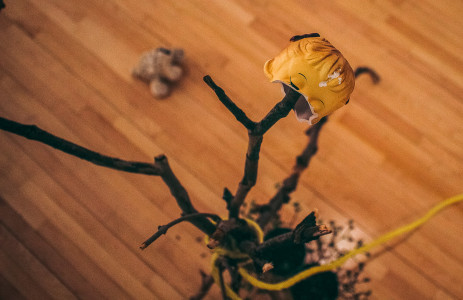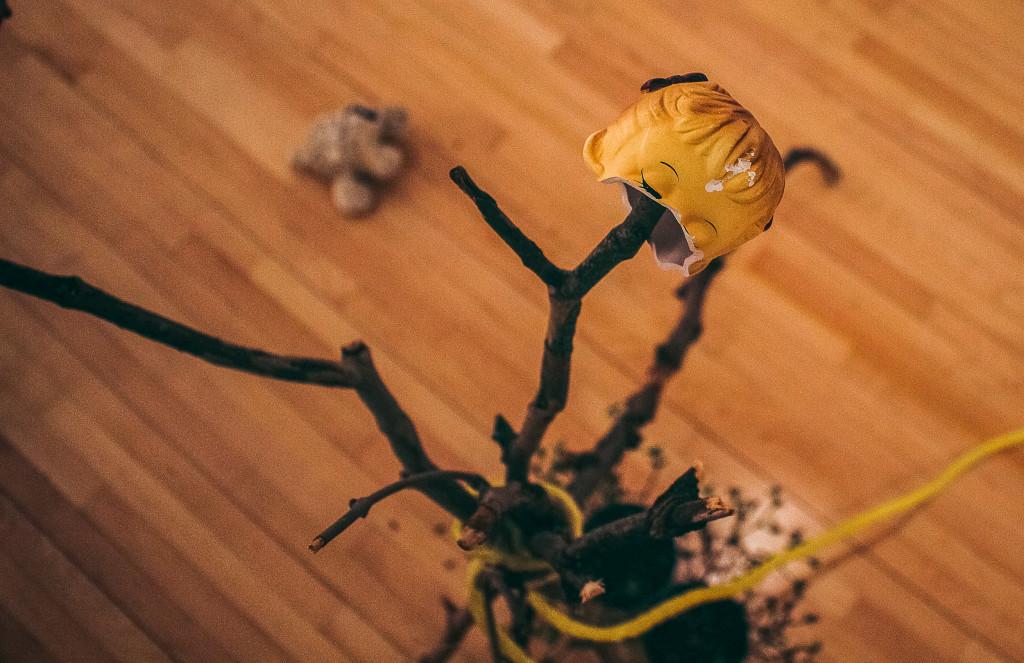Kelly Pyzik, Editor-in-Chief
pyzikkel@grinnell.edu
Do not be afraid to cross the line. The new Smith Gallery exhibit, “The End” by Nathan Kim ’16, centers on ideas of temporality, impermanence and the imminent end of the world. There is a yellow rope that separates the exhibit pieces from the gallery entrance, but viewers are encouraged to step over the line, take an artist’s statement and examine the exhibit up close in the ways they feel moved to.
“I think a lot of people feel afraid to step over this line, whereas in my head I was thinking, ‘Oh, wouldn’t it be great if there was a museum where you could step over all the things?’” Kim said. “I want people to make their own rules for interacting with the space.”
The separating rope is not meant to keep viewers from the art pieces, but rather to extract them from their everyday blindness to time steadily passing.
“I’m trying to think of this as an exhibit that focuses on the present as a moment that has already gone past. … In crossing this rope to grab the artists’ statement, I’m hoping to impart a certain awareness of yourself as a fading animal. I’m really interested in having viewers become part of the exhibit and trying to get this awareness of the end of everything. You don’t actually have to believe that, but still, I think it’s productive,” Kim said. “One doesn’t need to be a good person at the end of the world. I could just party every day if I wanted to, or I could just do some other stuff. It’s a lot of choices to make.”
On the right side of the exhibit lies a long piece of white butcher paper that has been covered in dried paint crumbles, the paint rubbed back and forth in large splotches creating what almost looks like an adult-size crayon drawing. A large broom lies against the wall at the end of the paper, with smaller piles of dried paint neatly assembled nearby, like when one sweeps up their kitchen before scooping it all into a dust pan. On top of each paint splotch is a piece of clean white paper, and then a ceramic figurine, which has been smashed and glued into a new, disorderly form. As a whole, the piece seems to reflect an aftermath, but the nostalgia and bright colors of the figurines also add a feeling of hopefulness, or at least happy memories.

“They’re kind of relics, but they also don’t make sense. Precious Moments dolls … it’s strange that we mass produce those things,” Kim said of the piece. “I tried to reference abstract expressionism. There’s something really grandiose and arrogant, you’d have to have a huge ego to just make a pile of shit and decide it’s art, so I was kind of punning on that. I’ve got this big broom against the wall and I was just sweeping paint around. But then there’s white paper on top so it turns into a placemat. It’s also about turning high art into placeholders, … nothing, trash.”
While in past shows Kim has begun with a concept in his head and then created pieces stemming from that, this show has been an experiment in new methods of creation.
“A lot of this is just me coming up with a cohesive framework for just a bunch of things I’ve been interested in: … the end of the world, accidents, making art without intention. … This is just an outpouring of a bunch of things that felt right to me,” Kim said. “I mean, I’m an undergraduate major, not everything I make is going to be good, and I’m totally fine with that.”
While considering the end of the world and reflecting on the emotional atmosphere of our current era, Kim saw a lack of the optimism that seemed to fill the ’70s and ’80s. He feels these decades were more hopeful, and driven to pass on a legacy to the future which seemed sure to come. He sees our current relationship with money and technology as the new target of cultural optimism.
“We keep putting money into technological discovery, but it just seems like the wrong line of thinking. This might not be related to my show so much as what I’m thinking about when I’m making stuff, but it seems a little bit strange to be so in favor of producing new things when it’s producing new things that don’t expire, that don’t decompose. … We’re drowning in trash—this is a lot of trash,” Kim said as he gestured to the exhibit.
The process of creating “The End,” for Kim, has been an investigation into both materials that interested him and ideas that plagued him.
“[Through making this exhibit, I’ve been] just trying to comes to terms with the end of the world and how you’ve got to keep making stuff,” he said. “I mean, the end of the world could be any time. … If we have no future, then why make anything? If there’s no history to pass on, why do anything? But at the same time, that gives certain things like this special significance.”





























































